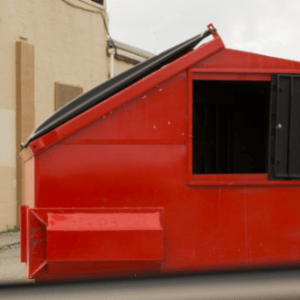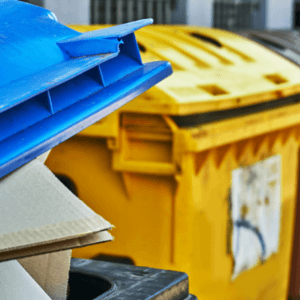Are you tired of looking at your old, outdated tile? Thinking of ditching the tub in favour of a modern, walk-in shower? You'll have to remove the current bathroom and install the new one. For those who want to hire a professional to oversee the rest of the renovation, demolition dumpster rental on their own and using a dumpster rental are simple ways to cut costs.
This work is physically demanding but requires no specialized skills. It's a simple job that the average homeowner can do with just a few items from around the house.

First, ensure that the door is shut and latched before continuing with this task. After that, remove the hinge pins by hitting the underside of each pin with a nail to loosen it. Use your fingers to draw them out of the hole when they have risen about an inch or two. If they don't budge, use a screwdriver with a flat blade to pry up on the knuckle's underside.
.
The vent cover should be unscrewed and set aside. You can get rid of the dust that has settled inside the metal duct by wiping it down with a moist rag.
To use aluminium tape, you'll need to rip it into long enough strips to wrap around all four sides. There should be two shorter and two longer sections.
It's important to peel off the tape's backing slowly and carefully. You only have one chance to aim, so make it count!
Ensure the tape sticks to the first few inches of the metal duct and extends about a quarter of an inch down onto the floor. Put some serious pressure on it, and it will stay put. Do the same on the opposite side, completely sealing the seams between the tape.
Even while the tape performs excellent sealing, it may become loose as the metal expands and contracts with the seasons. A duct sealer is necessary for this purpose.
Use a putty knife to spread a thick layer of duct sealer on the aluminium tape. Be sure the sealer meets the floor, but don't get any on the tape. Avoid turning onto the tape placed directly on the ground as you ascend.
Make sure there are no globs of sealer on the floor, and clean up any mess you caused before waiting for the sealer to dry. Go to the next vent on your floor and do the same thing there.

A toilet may be more difficult to remove than other fixtures in your bathroom, but it is still possible to do so. Before doing anything else, turn off the water and remove the cistern from the toilet.
At times, glue and silicon sealant stick toilet bowls to the floor. If that's the case, pry the toilet bowl with the bar. You can easily remove the bathroom equipment from the wall and lift it off the floor.
After removing the old hardware, it's time to focus on the sink and vanity. To access the drain lines, unscrew the P-trap that connects the sink to the plumbing. Unscrew the sink from the wall brackets and disconnect the water lines (if any). Using the pry bar, you can pry your sink loose if it is stuck.
You can easily remove your bathroom vanity by unscrewing its cabinet from the wall (if it has one). If your vanity is similarly screwed on too tightly, you can use your pry bar to remove it.
You will need the following tools and materials:
You may need other materials and tools, depending on how the floor looks after the tiles. Don't forget about safety equipment. When you take tiles off a concrete floor, there is a lot of dust and debris in the air, and you may need to use harsh chemicals.
Wear a respirator mask that fits well, eye protection, a long-sleeved shirt, and work gloves to keep from getting hurt or breathing in dust. Also, because you'll be kneeling on a hard surface a lot, invest in a pair of kneepads.
If you are taking up linoleum or vinyl tiles that were put down before 1980, make sure they don't have asbestos. Asbestos was once mixed into vinyl floor tiles to improve insulation and fire resistance. Asbestos may be present in the glue used to adhere to these tiles.
The asbestos tile should only be taken off by a trained professional because it can be hazardous to your health if it gets broken up. You may keep the tiles in place and cover them with concrete.
Find a good place to start when removing ceramic tiles to quickly get the masonry chisel under the tile. It's best to see or feel a cracked or loose tile. Areas with deteriorating grout are also good starting points.
Work the masonry chisel under the tile at a 45-degree angle, so you don't gouge the concrete floor. Take a few good whacks with a mallet on a chisel until you can loosen and pry off the tiles.
If you come across a stubborn tile that won't budge, smash it into pieces using a sledgehammer.
Work the masonry chisel under the tile at a 45-degree angle, so you don't gouge the concrete floor.
Removing vinyl tile or linoleum flooring requires a different approach because the tiles are pliable and will not crack like ceramic tiles. Here's how:
With a putty knife, pry up one corner of one of the vinyl tiles. You may have to use a utility knife to cut through the tile if there isn't a loose corner.
Next, slide a floor scraper or a putty knife underneath the tile and lift it completely off. If the tiles are hard to move, heat them with a hair dryer or heat gun. This will soften the glue and make them easier to scrape up.
Once you've removed all the tiles from a concrete floor, your work is far from done. You will also have to remove any underlayment or backer board under the tiles. But the job would often be challenging if the tile was put down directly on the concrete without an underlayment.
Most of the time, tiles are stuck to concrete subfloors with either adhesive mastic or thinset mortar. The removal method you use will vary depending on the material.
If removing mastic, scrape it with a broad chisel or long-handled floor scraper. If that doesn't work, try softening the mastic with hot water (most tile adhesives dissolve in water) or a commercial mastic remover made just for getting old adhesive off concrete floors.
When the mastic starts to dissolve, return to it with the scraper. (Learn more about removing glue from a concrete floor.)
Unlike mastic, thinset hardens into a cement-like substance that you can't remove by dissolving. You have to chip away at it repeatedly with a chisel, a floor scraper, or a rotary hammer with a thin-set removal bit. Wear a face mask and goggles when removing the thin set, regardless of the method.
If scraping and mastic removers don't get the job done, you can grind off any leftover thin-set or mastic with a concrete grinder and then use an angle grinder to work with tiles along the walls and in corners.
Most of the time, grinding is the best way to get a smooth surface and get concrete ready for a decorative finish.
Because concrete grinding equipment is expensive, consider renting one from a home improvement store. To make cleanup easier, use a grinder that has a port for connecting a dust vacuum, allowing you to collect the grinding dust as you work.
If you've never used a concrete grinder before, consider hiring a professional contractor who will know which grinding discs to use and how to operate the machine without damaging the concrete surface.
Note: If you're doing the work yourself, be sure to put on some long pants and a long-sleeved shirt. Don't forget to wear safety goggles, leather work gloves, and a respirator mask with two cartridges.

Dumpster Rentals in Woodstock, GA, is a family-owned and operated company. Our employees know how to rent roll-off dumpsters for commercial and residential construction projects in the area.
We have different sizes of dumpsters so that we can help with a wide range of cleaning projects, from cleaning out the garage to getting rid of the trash from a construction site.
Contact us today to get started on your bathroom demolition and other projects you may have. We're ready to help!